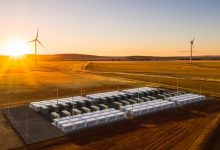The completion and payment for Tesla first two big batteries in Australia has helped the australian offshoot record a near 10-fold increase in revenue from battery storage operations in 2018, even if revenue from the sales of electric cars fell 26 per cent.
According to documents filed with the Australian Securities and Investment Commission by Tesla Motors Australia late last week, overall revenue for the 2018 calendar year jumped 65 per cent to $330 million, from $194 million.
It delivered a near four-fold lift in profit for the calendar year to $5.6 million for the Australian operations.
The biggest component of this revenue – unlike the previous year – was storage revenue, which jumped from $22 million to $202 million, likely reflecting the completion and payment of the Tesla big battery at Hornsdale in South Australia, and the Gannawarra Energy Storage System in Victoria.
The 100MW/129MWh Hornsdale installation cost around $95 million – and while switched on in December, 2017, did not go through its final formal commission until early 2018, although it has already delivered handsome returns to its owners, Neoen Australia.
The 25MW/50MWh Gannawarra battery, located next to the solar farm of the same name, was completed – at a cost of $35 million – late last year.
The balance of the storage revenue would have been made up from the sale, delivery and installation of Tesla Powerwall batteries for households, and some other commercial and industrial installations using the bigger, 200kWh, Powerpacks.
Production and delivery of both Powerwalls and Powerpacks were delayed through much of 2018, mostly because Tesla through all its resources to delivering the Tesla Model 3 EV and removing any production blockages. Elon Musk says those constraints have now been relaxed.
Tesla has some other large scale battery storage installations due to be complete this year, including the $38 million and 25MW/52MWh battery at the Lake Bonney wind farm in South Australia, a 20MW/34MWh facility at the Bulgana wind farm in Victoria, an the smaller 2MW/4MWh installation at the Kennedy wind-solar-battery complex in Queensland.
Tesla also has a contract to supply batteries for a 4MW/8MWh facility to be built in Townsville later this year for the government owned Yurika, which has said it plans another nine similar battery installations across the grid.
Tesla books revenue from the batteries at the point of delivery and completed installation. It does not own the battery once installed.
The revenue from automotive sales was down 26 per cent to $125 million, but it is unclear to what extent this reflects a fall in the number of Tesla electric cars sold, or a fall in price.
Many Australian consumers have been waiting – some its unveiling in 2016 – for the delivery of the lower priced Model 3 EV, so it’s not clear to what extent that affected revenue.
There was $4.1 million in revenue from services, which includes repairs and maintenance services and service plans.
Other interesting points about the results are the $2.8 million spent on marketing activities, and the $5.1 million spent on rent – presumably for their various showrooms.
Its net cash outflow from operating activities was $26 million but it balanced this out with a cash injection from its parent of $24 million and from some more borrowings. It has 257 employees in Australia, as at December 31.








